
Tyres
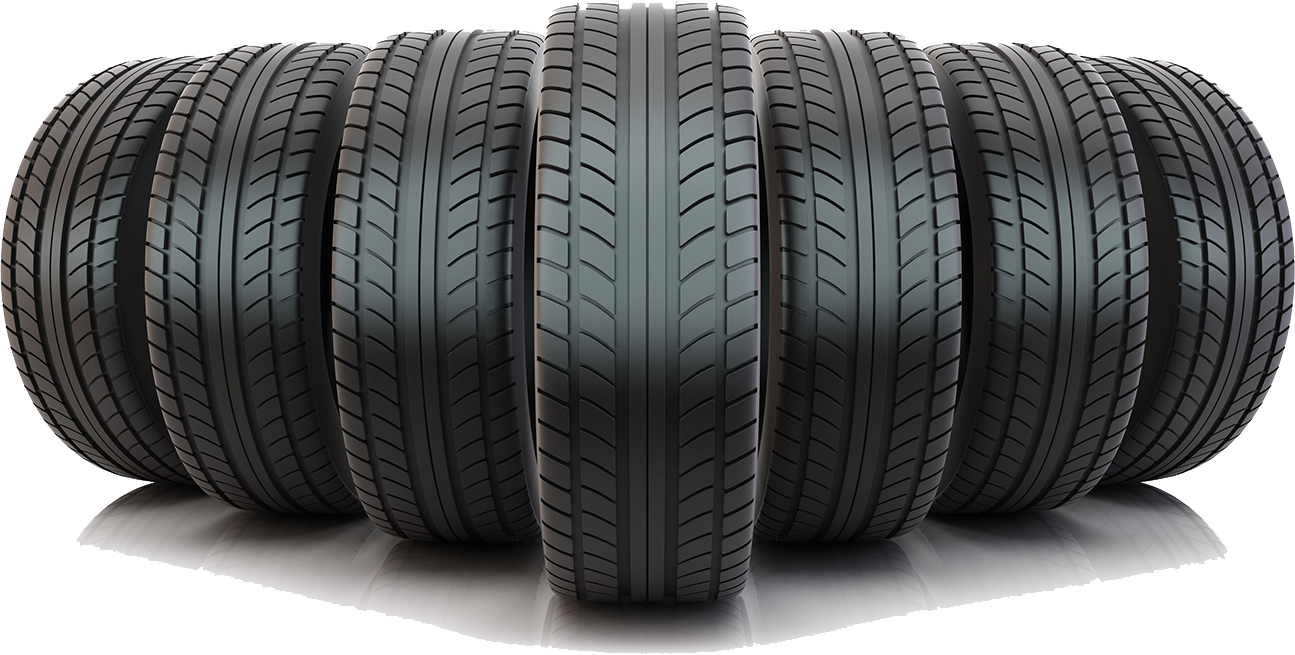
We fit tyres. We offer tyre fitting on all cars and vans using the most up to date machines. We can replace many types of tyre including Low profile tyres, Run-flat tyres, Van tyres, 4×4 Tyres, Track-day tyres and more.
We can offer TPMS diagnostics and valve sensor service & replacement and most makes of tyres available either same or next day.
WHAT IS A TYRE?
A tyre is a ring-shaped component that surrounds a wheel’s rim to transfer a vehicle’s load from the axle through the wheel to the ground and to provide traction on the surface over which the wheel travels. Most tyres, such as those for automobiles and bicycles, are pneumatically inflated structures, which also provide a flexible cushion that absorbs shock as the tyre rolls over rough features on the surface. Tyres provide a footprint, called a contact patch, that is designed to match the weight of the vehicle with the bearing strength of the surface that it rolls over by providing a bearing pressure that will not deform the surface excessively.
The materials of modern pneumatic tyres are synthetic rubber, natural rubber, fabric and wire, along with carbon black and other chemical compounds. They consist of a tread and a body. The tread provides traction while the body provides containment for a quantity of compressed air. Before rubber was developed, the first versions of tires were simply bands of metal fitted around wooden wheels to prevent wear and tear. Early rubber tires were solid (not pneumatic). Pneumatic tires are used on many types of vehicles, including cars, vans, bicycles, motorcycles, buses, trucks, heavy equipment, and aircraft. Metal tires are still used on locomotives and railcars, and solid rubber (or other polymer) tires are still used in various non-automotive applications, such as some casters, carts, lawnmowers, and wheelbarrows.
WHAT TYRES SHALL I CHOOSE?
The tyre you need depends greatly on the kind of car you drive and the type of driving you do. If you drive short distances in and around town on the school run or to the local shops, then economy and safety will be a primary concern when choosing a tyre. If you do a lot of motorway driving then low noise, comfort and fuel saving might be factors in helping you find the right tyre. Drivers with luxury cars and sports cars will be interested in high performance tyres, which offer precision handling, excellent traction and manoeuvrability at speed.
Load ratings, speed ratings, sidewall aspect ratios; finding the right tyres for your car can be a real minefield if you do not know what you are looking for. Even once you know your size there can be so many options available, but which one should you choose?
Let us start off by finding out what size you need. The easiest way to do this is to simply look at what is fitted to your car already. Tyre’s will always have the size written on the side of the tyre somewhere, usually in bold writing alongside the manufacturer. Be sure to check both the front and rear tyres, some vehicles may have a different tyre size on the front axle and rear axle.
The tyre size is usually split into four sections: width, profile, rim size and load & speed ratings.
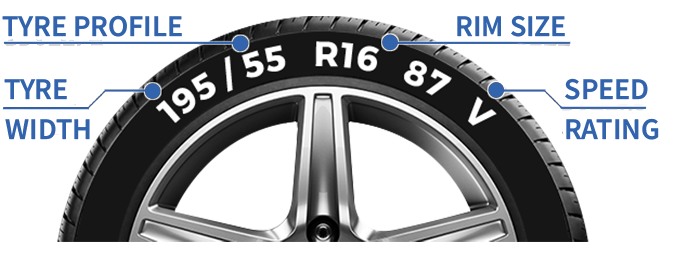
- 205 is the width in millimetres of the tyre’s cross-section.
- 55 is the ‘aspect ratio’ – the ratio of the sidewall height to the tyre’s cross-section width.
- R stands for radial-ply construction (nearly all tyres are of radial-ply construction).
- 16 stands for the diameter (in inches) of the wheel that the tyre is designed to fit.
- 91 is the load index which corresponds to the maximum load a tyre can carry at full speed (indicated by its speed rating – below). To find out your load index, locate the number on the sidewall of your tyres and refer to the load index table on our information page.
- V is the speed rating which indicates the maximum speed for the tyre when the vehicle is at full load. Generally, maximum tyre speed is rated in alphabetical order. However, W and Y rated tyres are a special case as they can operate at higher maximum speeds than older Z rated tyres. It is therefore safe to replace your current Z rated tyres with W or Y rated tyres.
When selecting new tyres, it is important to be aware that you should never fit tyres with a lower load or speed rating than what has been fitted by the vehicle manufacturer. It is however ok to fit tyres with a higher load or speed rating, though tyres with higher load rating may impact vehicle handling slightly. It is worth checking your vehicle owner’s manual or contacting us if you are ever unsure.
EU TYRE LABEL
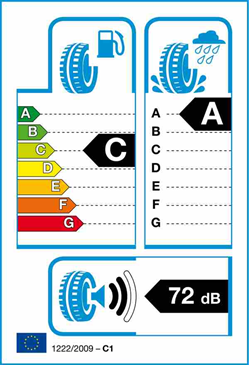
As of November 2012, all new car, 4×4, SUV, van and most truck tyres manufactured after 1st July 2012 carry an EU tyre label which is very similar to the energy stickers that appear on white goods.
No two makes of tyre are the same, so the EU tyre label has been created to provide drivers with objective, reliable and comparable information about each tyre so that you can make a more informed choice when buying new tyres. The EU’s targeted outcome is that road safety will improve and that the environmental impact of road transport will be reduced.
Every tyre is assessed on three key areas of tyre performance and given a rating in each of these three categories for the EU tyre label, allowing the consumer to compare tyres on a like-for-like basis. The three areas assessed are:
Fuel Efficiency – How economic is this tyre? – Savings
Wet Grip – How quickly can the tyre stop in wet conditions? – Safety
Exterior Noise – How noisy is the tyre? – Volume
FUEL EFFICIENCY
The EU tyre labelling criteria looks at the rolling resistance of the tyre in order to rate its fuel efficiency. Rolling resistance is the force acting opposite to the tyre’s direction of travel. As a tyre rolls along the road it creates friction, the higher the friction the more energy will be needed to keep the tyre rolling, making the engine work harder and using more fuel. Tyres with low rolling resistance place lower demands on fuel since less energy is being used as the tyres roll along the road.
The difference in fuel consumption between a car fitted with A and G class tyres is around 0.5 litres per 100km, that’s a saving of around 80 litres and more than £110 per year. *
Other factors affect fuel consumption such as aerodynamics, vehicle weight, type of engine, auxiliary systems like air-conditioning slope of the road, personal driving style, tyre pressure level, accelerations or general traffic conditions.
*Savings based on a petrol engine car travelling 10,000 miles per year with £1.40 per litre fuel cost
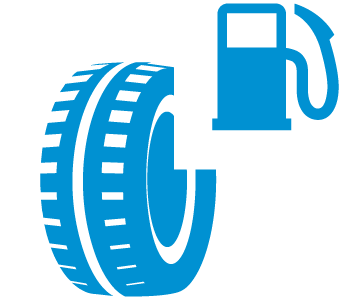
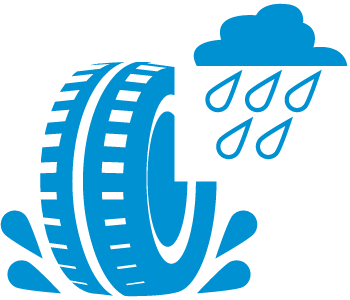
WET GRIP
Tyres with excellent wet grip have shorter braking distances on slippery roads and increased aquaplaning resistance, essential for keeping you safe in the rain.
These ratings are measured from the distance travelled by a car after braking at 50mph in the wet.* Tyres with the best EU tyre label rating for wet grip will exhibit a 30% shorter braking distance than those with the worst rating for a full set of tyres fitted to an average car.
A tyre’s EU tyre label wet grip rating reflects the capacity of the tyre to brake on a wet road. However, there are other parameters which are relevant for safety (e.g. road holding ability, directional control, deceleration ability on wet and dry surfaces at higher speed and aquaplaning behaviour) but wet grip was chosen by the EU as the most representative situation of reduced adherence in Europe.
*Testing according to regulation EC 1222/2009
EXTERIOR NOISE
Exterior noise levels are measured in decibels (dB) and shown as one, two or three sound waves on the EU tyre label.
One wave is the best performance, three is the worst. In fact, three bars is the current limit, while two meets future laws and one is a further 3dBs below.
The EU tyre label only measures the external rolling noise of the tyre which is not related to the in-cabin noise that the driver will experience.

Tyres and the Law
UK law requires that your vehicle be fitted with the correct type and size of tyre for the vehicle type you are driving and for the purpose it is being used, this means fitting the right tyres and for safety ensuring that they are inflated to the manufacturer’s recommended pressure.
The legal limit for minimum depth of the tread on your tyres is 1.6 millimetres, across the central ¾ of the tread around the complete circumference of the tyre.
For safety reasons it is recommended that you replace your tyres before the legal limit is reached. Many vehicle manufacturers recommend replacing at 3 millimetres, as below this depth stopping distances start to dramatically increase. At 1.6 millimetres in wet weather it takes an extra two car lengths (8 metres) to stop at 50 mph than if your tread was 3 millimetres.
As well as the minimum tread depth, it is also important to make sure that your tyres are free of any other defects. Lumps, bumps and bulges could mean the tyre is structurally damaged, while any cut of tear bigger than 25mm, or 10% of the tyre’s width, can mean your tyres are not road legal. The same applies if any part of the tyre’s ply or cord are exposed.
A regular check of your tyres can help you to avoid 3 penalty points and £2,500 in fines for having tyres worn beyond the legal minimum limit on your vehicle.
It is also a legal requirement to ensure that tyres of different construction types are not fitted to opposite sides of the same axle. The two main tyre types are radial and cross-ply, and these must not be mixed on the same axle.
Mixing brands and patterns of the same construction type is permissible depending on the vehicle type and manufacturers recommendation. Check your vehicle’s handbook for tyre fitment details and options or ask us for more details.
Tyre Pressures & Tyre Repairs
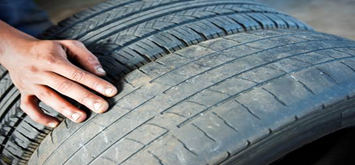
Over or under inflated tyres can be highly dangerous and can risk putting you and your passengers at danger.
Keeping your tyres at the recommended pressure will improve the life of your tyres, reduce fuel consumption and minimise risks of lower grip and longer breaking distances.
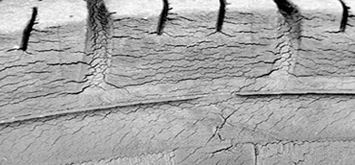
Tyres can deteriorate with age which shows as cracking on the tread and sidewall rubber. Cracking is usually an indication that tyres have been in use an extremely long time. All tyres have a date marking which determines week and year of manufacturer. If cracking is severe the tyre must be replaced. Tyres fitted to caravans and boat trailers which are parked for long periods of time, particularly in coastal regions, will tend to age and crack more quickly than those which are used and run frequently.
In principal, a tyre’s lifespan is around ten years, however a ‘new’ tyre is designed to last between one to five years if it is correctly stored when not in use. Both physical and chemical reasons cause tyres to age and this can also happen to tyres that are rarely or never even driven on.
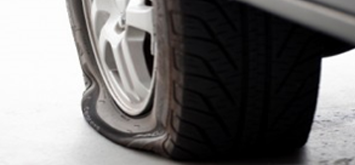
It is sometimes possible to have your tyres repaired, they don’t always have to be replaced.
Repairs to tyres and tubes must be carried out to meet the British Standard AU 159 and should always be entrusted to a specialist.
Essentially, this means plugging a hole, not patching over it.
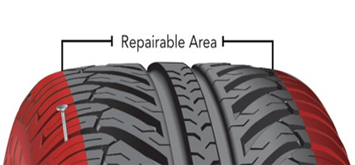
All punctured or damaged tyres should be removed from the wheel for internal and external examination to ensure that there is no hidden damage that could cause a later failure.
For safety reasons, repairs should only ever be carried out in the safety zone shown below, and subject to technicians’ recommendations. Any repair outside of the safety zone is classed as a dangerous repair and not permissible.
To ensure even wear and tear on your tyres and tyres should always be re-balanced after a puncture repair.
Tyre Pressures & Tyre Repairs
An increasing number of vehicle makes and models are fitted with tyre pressure monitoring systems (or TPMS for short) and all new vehicles manufactured since 2014 have TPMS integrated as standard.
A faulty TPMS sensor can now result in an immediate MOT failure. As of 1st January 2015, any car manufactured from 2012 onwards that is displaying a TPMS warning light on the dashboard will automatically fail its MOT test.
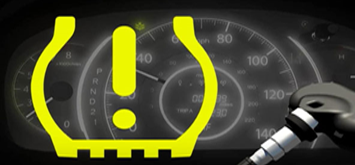
A sensor valve in each tyre monitors tyre pressures and reports low pressures or tyre pressure imbalances to the driver via the dashboard display. TPMS sensors in the vehicle show a warning light when there is a drop in pressure of between 6-7PSI. This is now a legal requirement although some manufacturers set their warning lights to come on when sensors detect much smaller decreases for additional peace of mind.
TPMS sensors should be serviced regularly to avoid sensors developing faults. One of the most common TPMS sensor issues is battery failure. The more miles you travel, the quicker the battery will deplete. TPMS sensor stems can also become corroded and rubber types can perish and crack over time just like standard tyre valves as they are open to the elements and take on everything the road throws at them.
Wheel Balancing
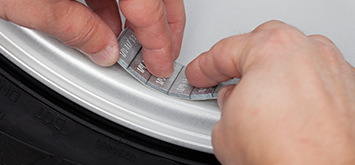
Wheel balancing helps to ensure that the weight of the wheel is even when it turns. Every time a new tyre is mounted onto an axle, the wheel should be rebalanced to ensure it continues to rotate evenly.
Wheels that are not balanced or are out of balance generally produce a vibration that is uncomfortable to the driver and results in premature wearing of tyres, suspension and steering components.
The first sign that your wheels may be out of balance is when your steering wheel starts to wobble above a certain speed causing considerable discomfort while holding the wheel.
Drivers may not always sense an imbalance at the steering wheel which could be dampened by the vehicle weight. However, uneven tyre wear is another sign that your wheels may be incorrectly balanced.
Wheels can be balanced on a wheel balancing machine. The machine rotates the tyre and wheel assembly and automatically calculates even the smallest differences in weight across the wheel. The balancing machine then highlights the exact position where a balance counterweight should be applied. Counterweights come in different sizes depending on the degree of the imbalance.
Wheel balancing can help to eliminate this vibration and you should notice a smoother ride. You will also experience more even tyre wear which will help to increase the life of your tyres, saving you money in the long run.
Newington
Sittingbourne
Kent
ME9 7PE